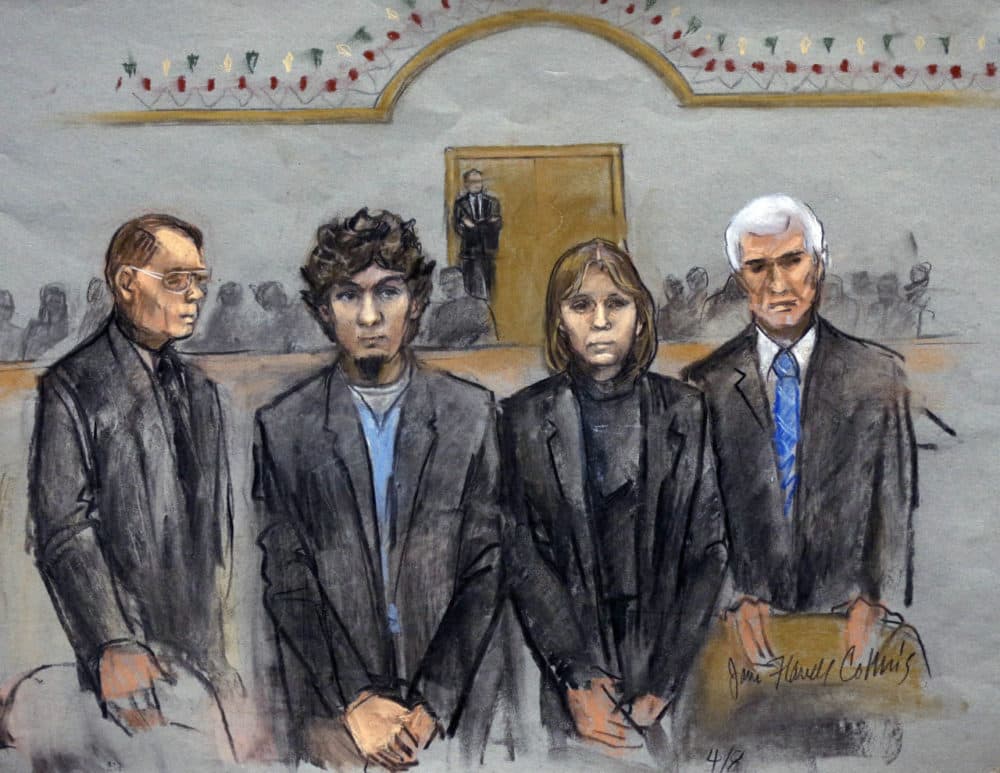Advertisement
As Tsarnaev Jurors Deliberate His Sentence, Here's What They Are Considering

After three weeks of testimony in the penalty phase of the Dzhokhar Tsarnaev trial, a jury of 12 Boston-area residents is now deciding the fate of the convicted Boston Marathon bomber.
Jurors heard from 63 witnesses over 13 days. About two-thirds of those witnesses were called by the defense — including Tsarnaev's relatives, former teachers, friends and even a nun who advocates against the death penalty and said he expressed sorrow for the victims.
The defense aimed to convince jurors he fell under the influence of his older brother, Tamerlan, and that mitigating factor and others should save him from death.
The jury also heard gut-wrenching testimony from bombing victims as prosecutors aimed to portray Tsarnaev as a willing partner of his older brother and a heartless terrorist who deserves the death penalty.
Now, the jury must weigh everything they have heard and impose a sentence. Here is a look at the jury's deliberation process, in FAQ style (Also, see below for the jury verdict form):
What has to happen for the jury to impose the death penalty?
Jurors must be unanimous for Tsarnaev to be sentenced to death. If even one juror votes against the death penalty, Tsarnaev will be sentenced to life in prison without the possibility of parole.
What charges are the jurors considering?
The jury will look at the 17 death penalty charges Tsarnaev was convicted of in the first phase of the trial. They must decide on a sentence (life or death) for each of these capital counts.
Can the jury choose the death penalty or life in prison on only some charges?
Yes. The jury may choose the death penalty for some charges and not others. They may also choose a life sentence for some charges and not others.
The jurors only have to vote for the death penalty on one charge for Tsarnaev to be sentenced to death. For example, if the sentences are split 10 life in prison and 7 death penalty, the death penalty would be applied.
What does the jury have to do to determine a sentence for each count?
The jury will be weighing a number of aggravating and mitigating factors.
The aggravating factors represent the government's case. They are basically what the government argues justifies a sentence of death. These factors were outlined in prosecutors' notice of intent to seek the death penalty.
The mitigating factors represent the defense's case. They are basically what the defense argues should spare Tsarnaev from the death penalty. The jury does not have to be unanimous in deciding whether there are mitigating factors. They can decide individually if they believe a certain one of these factors has been proven.
Also, as the jury deliberates they can submit written questions to the judge for clarification on any issues they have.
What are some of the aggravating factors?
The government has listed 17 different factors for pursuing the death penalty (12 are categorized as aggravating factors). The first factor they must consider is Tsarnaev's age (that he was over 18 at the time of the crime). After that jurors must consider four gateway factors then six statutory aggravating factors and then six non-statutory aggravating factors.
Gateway factors include things such as Tsarnaev intentionally killed the victims and intentionally participated in the bombing. Some of the statutory aggravating factors are that Tsarnaev committed the crime in an especially heinous manner and intentionally killed Martin Richard, who was especially vulnerable due to his young age. The non-statutory aggravating factors include that Tsarnaev made statements saying others would be justified in committing acts of terrorism against the U.S. and that he lacked remorse for his actions.
What are some of the mitigating factors?
The mitigating factors represent what the defense tried to show during the sentencing phase of the trial. There are 21 mitigating factors defense attorneys outlined, including that the bombing was planned out and led by Tsarnaev's radicalized older brother, Tamerlan. Some of their other mitigating factors include that Tsarnaev was young at the time of the crime, had no prior history of violence, had an unstable and dysfunctional family with mental illness, and expressed sorrow and remorse for his crime.
What does the jury have to do once they have decided on the aggravating and mitigating factors?
The jury will then determine its sentence for each of the capital counts.
In order to impose the death penalty on a particular count, the jury must unanimously agree that the government has proven all of the following:
- Tsarnaev was 18 or older at the time of the crime
- At least one of the gateway factors (beyond a reasonable doubt)
- At least one of the statutory aggravating factors (beyond a reasonable doubt)
If the jury does not unanimously agree on those factors, they cannot consider the death penalty on that charge. In that case, their deliberation would be over for that particular charge and — with the death penalty off the table — a life sentence would be imposed for the charge.
It's important to note that the defense on Wednesday sought to have Judge George O’Toole instruct jurors that if they failed to reach a unanimous verdict about the death penalty, the judge would impose a sentence of life without parole instead. Defense attorneys argued that without that instruction, jurors could mistakenly believe there would be a hung jury and feel pressure to change their minds to avoid that scenario.
As WBUR's David Boeri reported, that instruction has been given by judges to jurors in two other federal death penalty cases in Massachusetts. But, in this case, O'Toole denied the motion.
Once the jury completes its deliberations, the forewoman will submit their final verdict form to the judge and court will resume, at which time the verdict will be read.
Below is the verdict form the jury will fill out during its sentencing deliberations. It provides detailed jury instructions and information on all of the factors the jurors must decide on in its deliberations.
